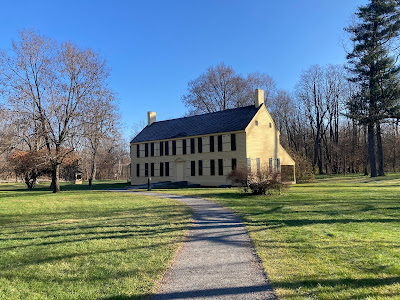Surrender At Saratoga - "The Greatest Conquest Ever Known"
For some time I assumed Lieutenant-General John Burgoyne's Saratoga Campaign came to an end in mid-October of 1777, when his army had advanced south as far as it was able, only to be stopped in its tracks and forced to surrender. When I started exploring the route of the Convention Army, I assumed that the Surrender Site would be where British and German troops had laid down their arms. Now, after some additional research, and a weekend visit to Saratoga National Historical Park, I've learned those assumptions were wrong - and another visit to Schuylerville is in order, as there is more to see there than I'd realized.
The story of Burgoyne's surrender at Saratoga is linked to a a number of locations. One would be what is now called "Victory Woods", a misleading name from the British perspective perhaps, that reflects its location in the present-day Village of Victory, incorporated in 1849, rather than any description of the site in 1777. It was there, after a night move north away from Bemis Heights on October 9th, that Burgoyne gathered his forces in what became their final defensive position.
For four days the opposing armies exchanged cannon fire and musket shot as American Major-General Horatio Gates' position grew stronger, and Burgoyne's weaker through casualties and desertions. On the 14th, American Light Infantry forces commander Major Henry Dearborn noted "at 10 O Clock to Day a flag Came from Genr'l Burgoyn with some Proposals of Caputilation in Consiquence of which a sessation of armes was agreed on until sun set in which Time several flags Pass.d Between Genr'l Gates and Burgoyne." [1]
For two more days the ceasefire continued, as Burgoyne worked out an agreement with Gates. Blocked by militia units on the east bank of the Hudson River and pressured by Major-General Horatio Gates' Continental Army brigades, Burgoyne realized it was unlikely he would be able to retreat north to Fort Ticonderoga, and agreed to the terms of the Articles of Convention. Included was that on the 17th the formal signing of the Convention would occur at 9:00, and Burgoyne's troops would march out of their ""Victory Woods" camp "to the verge of the river where the old fort stood, where the arms and artillery are to be left..." [2]
My visit to Saratoga included a stop at the Surrender Site, which offers a view of the Hudson River Valley, and to the southeast, the first of the mountain ranges the Convention Army would need to cross. Today several stone monuments and two reproduction British cannons mark the site where signage indicates that it was here that Burgoyne offered his sword in surrender to Gates.Less well known, to me at least, was "where the old fort stood", the site of Fort Hardy in the Village of Schuylerville. It was here that British and German troops laid down their arms. British Lieutenant William Digby of the 53rd Regiment of Foot noted of the British, who marched out before the Germans "About 10 o'clock, we marched out... though we beat the Grenadiers march, which not long before was so animating, yet then it seemed by its last feeble effort, as if almost ashamed to be heard on such an occasion. As to my own feelings, I can not express them. Tears (though most unmanly) forced their way, and if alone, I could have burst to give myself vent." Major-General Friedrick Riedesel, commander of the German forces, recalled in his Memoirs "At eleven o'clock, the army left their old fortified camp, and formed in line on the ground near the so called old fort, - this [north] side of the Fishkill. Here they left their cannon and muskets..." [6]

For more on the Convention Army's 1777 march from Saratoga to Boston, see:
1777 March Blog Home Overnight Stopping Points Towns and Villages Along the Way




Comments
Post a Comment